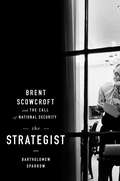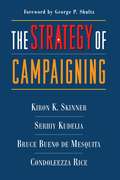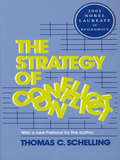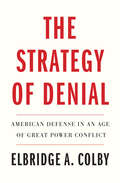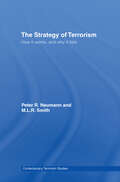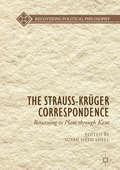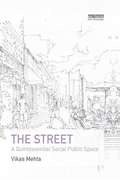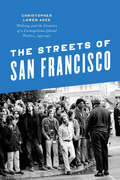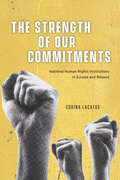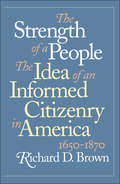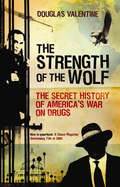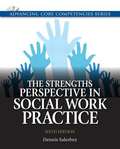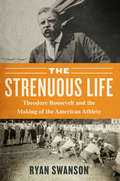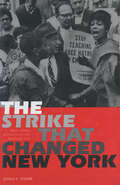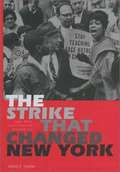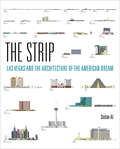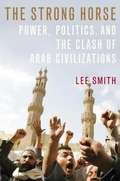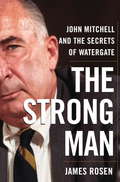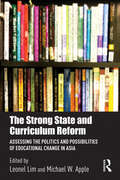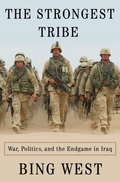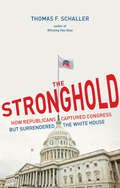- Table View
- List View
The Strategist: Brent Scowcroft and the Call of National Security
by Bartholomew SparrowBased on the full cooperation of the subject--with no restraining conditions--The Strategist provides an in-depth portrait of a man whose career has been intimately linked to the great transformations in U. S. foreign policy, from the last third of the Cold War, to September 11, 2001, and up to the present. Bartholomew Sparrow brings color and focus to the complex and often secretive nature of U. S. foreign policy and strategic adjustments--an intellectual battlefield on which ideas and worldviews clash, in which economics, politics, and strategic concerns intertwine, and in which private citizens and non-office holders may exert as much influence as highly visible Cabinet officials. Among the most important foreign policy minds of the 20th and early 21st centuries, Brent Scowcroft is also among the least well-known or understood. In a now-famous August 2002 Wall Street Journal op-ed titled "Don’t Attack Saddam Hussein,” Brent Scowcroft, who had been national security advisor under President George H. W. Bush, went to war himself, in a sense, with his closest and longest-standing friends. He noted the scant evidence that tied the Iraqi government to terrorist organizations. He warned that an invasion and occupation of Iraq would be costly and potentially disastrous for a variety of carefully considered reasons. He recommended that the Bush administration work with the U. N. Security Council and wait for definitive proof of Saddam’s wrongdoing before taking action. The essay at once made Scowcroft the most outspoken and most credible critic of the Bush administration’s plans for war and immediately generated national controversy. It provoked a sudden, deep split in the Republican Party over the plans for war. Vice President Cheney, National Security Advisor Rice, Defense Secretary Rumsfeld, and President George W. Bush all vigorously reaffirmed their cause and their course of action, and the media and American public opinion soon fell in line. Clearly, Scowcroft, 84, continues to participate in the most central and important debates over U. S. foreign policy and national security. He has been a leading architect of U. S. foreign policy and grand strategy for almost a half-century, and though long out of office, still gives speeches, makes media appearances, and leads tasks forces and commissions. He is a rare creature, one of the few "wise men” of the nation’s capital: someone who is regularly consulted by top government officials in Democratic and Republican administrations, ranking members of the House and Senate from both sides of the aisle, and the country’s leading foreign-policy journalists. As recently as April 2009, Scowcroft co-chaired an extensive Council of Foreign Relations study of the U. S. nuclear weapons policy. More than anyone else, he stands at the center of the United States’ foreign policy establishment. Most significantly, Scowcroft is trusted--a scarce and typically fleeting quality in Washington--and has been for four decades. The unprecedented insights into the man and his career Sparrow offers in The Strategist are vital to anyone who wishes to understand America's changing role in the world.
The Strategy of Campaigning: Lessons from Ronald Reagan and Boris Yeltsin
by Bruce Bueno de Mesquita Kiron K. Skinner Condoleezza Rice Serhiy KudeliaThe Strategy of Campaigningexplores the political careers of Ronald Reagan and Boris Yeltsin, two of the most galvanizing and often controversial political figures of our time. Both men overcame defeat early in their political careers and rose to the highest elected offices in their respective countries. The authors demonstrate how and why Reagan and Yeltsin succeeded in their political aspirations, despite-or perhaps because of-their apparent "policy extremism": that is, their advocacy of policy positions far from the mainstream. The book analyzes the viability of policy extremism as a political strategy that enables candidates to forge new coalitions and outflank conventional political allegiances. Kiron K. Skinner is Associate Professor of International Relations and Political Science at Carnegie Mellon University, a Research Fellow at the Hoover Institution, and a member of the Chief of Naval Operations Executive Panel and the National Security Education Board. Serhiy Kudelia is Lecturer of Politics at Kyiv-Mohyla Academy, Ukraine and advisor to Deputy Prime Minister of Ukraine. Bruce Bueno de Mesquita is Julius Silver Professor and Director of the Alexander Hamilton Center for Political Economy at New York University and a Senior Fellow at the Hoover Institution. Condoleezza Rice is on a leave of absence from Stanford University, where she was a Professor of Political Science and a Senior Fellow at the Hoover Institution. She is currently serving as U. S. Secretary of State.
The Strategy of Conflict: With a New Preface by the Author
by Thomas C. SchellingA series of closely interrelated essays on game theory, this book deals with an area in which progress has been least satisfactory—the situations where there is a common interest as well as conflict between adversaries: negotiations, war and threats of war, criminal deterrence, extortion, tacit bargaining. It proposes enlightening similarities between, for instance, maneuvering in limited war and in a traffic jam; deterring the Russians and one’s own children; the modern strategy of terror and the ancient institution of hostages.
The Strategy of Denial: American Defense in an Age of Great Power Conflict
by Elbridge A. ColbyWhy and how America&’s defense strategy must change in light of China&’s power and ambition&“This is a realist&’s book, laser-focused on China&’s bid for mastery in Asia as the 21st century&’s most important threat.&”—Ross Douthat, New York Times Elbridge A. Colby was the lead architect of the 2018 National Defense Strategy, the most significant revision of U.S. defense strategy in a generation. Here he lays out how America&’s defense must change to address China&’s growing power and ambition. Based firmly in the realist tradition but deeply engaged in current policy, this book offers a clear framework for what America&’s goals in confronting China must be, how its military strategy must change, and how it must prioritize these goals over its lesser interests. The most informed and in‑depth reappraisal of America&’s defense strategy in decades, this book outlines a rigorous but practical approach, showing how the United States can prepare to win a war with China that we cannot afford to lose—precisely in order to deter that war from happening.
The Strategy of Freedom: An Open Letter to Students, especially American (The Works of Harold J. Laski)
by Harold J. LaskiIn this tract, Laski discusses the British case for the destruction of Hitler from the angle of the university student, especially from America, who had doubts about the complexities of the situation. He illustrates why all parties in Britain felt that future freedom of intelligence depended on victory.
The Strategy of Terrorism: How it Works, and Why it Fails (Contemporary Terrorism Studies)
by Peter R. Neumann M.L.R. SmithThis is the first book to set out a comprehensive framework by which to understand terrorism as strategy. It contends that even terrorism of the supposedly nihilist variety can be viewed as a bona fide method for distributing means to fulfil the ends of policy, that is, as a strategy. The main purpose of the work is to describe the dynamics of terr
The Strauss-Krüger Correspondence
by Susan Meld ShellThis book presents the first full translation of the correspondence of Leo Strauss and Gerhard Krüger, showing for each the development of key and influential ideas, along with seven interpretative essays by leading Strauss scholars. During the early to mid-1930’s, Leo Strauss carried on an intense, and sometimes deeply personal, correspondence with one of the leading intellectual lights among Heidegger’s circle of recent students and younger associates. A fellow traveler in the effort to “return to Plato” and reject neo-Kantian conventions of the day, Krüger was also a serious student of Rudolf Bultmann and the neo-orthodox movement in which Strauss also took an early interest. During the most intense years of their correspondence, each underwent significant intellectual development: in Krüger’s case, through a penetrating series of studies of Kant and Descartes, respectively, ultimately leading to Krüger’s conversion to Catholicism; and, in Strauss’s case, through the complex stages of what he subsequently called his “reorientation,” involving what he for the first time calls “political philosophy.” Readers interested in tracing the development of Strauss’s thoughts regarding a theological alternative that he found helpfully challenging—if not ultimately compelling—will find this correspondence to be an accessible point of entry.
The Street: A Quintessential Social Public Space
by Vikas MehtaReceived the Environmental Design Research Association's 2014 Place Book Award Shortlisted for the UDG Francis Tibbalds Book Award 2014 Good cities are places of social encounter. Creating public spaces that encourage social behavior in our cities and neighborhoods is an important goal of city design. One of the cardinal roles of the street, as public space, is to provide a setting for sociability. How do we make sociable streets? This book shows us how these ordinary public spaces can be planned and designed to become settings that support an array of social behaviors. Through carefully crafted research, The Street systematically examines people's actions and perceptions, develops a comprehensive typology of social behaviors on the neighborhood commercial street and provides a thorough inquiry into the social dimensions of streets. Vikas Mehta shows that sociability is not a result of the physical environment alone, but is achieved by the relationships between the physical environment, the land uses, their management, and the places to which people assign special meanings. Scholars and students of urban design, planning, architecture, geography and sociology will find the book a stimulating resource. The material is also directly applicable to practice and should be widely read by professional urban designers, planners, architects, and others involved in the design, planning, and implementation of commercial streets.
The Streets of San Francisco: Policing and the Creation of a Cosmopolitan Liberal Politics, 1950–1972 (Historical Studies Of Urban America Ser.)
by Christopher Lowen AgeeDuring the Sixties the nation turned its eyes to San Francisco as the city's police force clashed with movements for free speech, civil rights, and sexual liberation. These conflicts on the street forced Americans to reconsider the role of the police officer in a democracy. In The Streets of San Francisco Christopher Lowen Agee explores the surprising and influential ways in which San Francisco liberals answered that question, ultimately turning to the police as partners, and reshaping understandings of crime, policing, and democracy.The Streets of San Francisco uncovers the seldom reported, street-level interactions between police officers and San Francisco residents and finds that police discretion was the defining feature of mid-century law enforcement. Postwar police officers enjoyed great autonomy when dealing with North Beach beats, African American gang leaders, gay and lesbian bar owners, Haight-Ashbury hippies, artists who created sexually explicit works, Chinese American entrepreneurs, and a wide range of other San Franciscans. Unexpectedly, this police independence grew into a source of both concern and inspiration for the thousands of young professionals streaming into the city's growing financial district. These young professionals ultimately used the issue of police discretion to forge a new cosmopolitan liberal coalition that incorporated both marginalized San Franciscans and rank-and-file police officers. The success of this model in San Francisco resulted in the rise of cosmopolitan liberal coalitions throughout the country, and today, liberal cities across America ground themselves in similar understandings of democracy, emphasizing both broad diversity and strong policing.
The Strength of Bone
by Lucie WilkAn Amazon.ca Best Book of 2013: Top 100/Editors' Pick"A gorgeous debut."-JOSEPH BOYDEN, author of Through Black Spruce and The OrendaAt the hospital in Blantyre, Malawi, Bryce is learning to predict the worst. Racing heart: infection, probably malaria. He'll send Iris for saline. Shortness of breath? TB. Another patient rolled to the ward. And the round swellings, the rashes with dimpled centres, the small rough patches on a boy's foot? HIV. Iris will make him comfortable. They'll move on.Then there will be sleeplessness, rationed energy, a censuring of hope: the doctor's disease. Iris sees that one all the time.Henry Bryce has come to Blantyre to work off the grief he feels for his old life, but he can't adjust to the hopelessness that surrounds him. He relies increasingly upon Sister Iris's steady presence. Yet it's not until an accident brings them both to a village outpost that Bryce realizes the personal sacrifices Iris has made for her medical training, or that Iris in turn comes to fathom the depth of Henry's loss.The Strength of Bone is the story of a Western doctor, a Malawian nurse, and the crises that push both of them to the brink of collapse. With biting emotion and a pathological eye for detail, novelist and medical doctor Lucie Wilk demonstrates how, in a place where knowledge can frustrate as often as it heals, true strength requires the flexibility to let go.Advance Praise for The Strength of Bone"In supple, beautiful prose, Lucie Wilk recounts a doctor's struggle with technology and faith, and with the mysteries of death and love ... The Strength of Bone is an extraordinary look at the clash of worlds."-ANNABEL LYON, author of The Golden Mean and The Sweet GirlLucie Wilk grew up in Toronto and completed her medical training in Vancouver. Her short fiction has been nominated for the McClelland & Stewart Journey Prize Anthology, longlisted for a CBC Canada Writes literary prize, and has appeared in Descant, Prairie Fire and Shortfire Press. She is working toward an MFA in Creative Writing at the University of British Columbia. She practices medicine and lives with her husband and two children in London, UK.
The Strength of Our Commitments: National Human Rights Institutions in Europe and Beyond (Chicago Series on International and Domestic Institutions)
by Corina LacatusA deep dive into the mechanics of national human rights institutions and the forces that make or break their success. In the years since World War II, the endeavor to promote human rights has gained momentum and become increasingly important within international relations. Yet these efforts often run into serious problems of enforcement. Many countries formed national human rights institutions (NHRIs) with independent mandates to support and monitor government compliance with international human rights law. Be they commissions, ombudsmen, or tribunals, these institutions vary in their power and impact. For this book, Corina Lacatus surveyed NHRIs in Europe and around the world to determine their effectiveness and explain why some succeed while others fail. The Strength of Our Commitments explores the relationship between the domestic and international support an institution receives and its ability to secure resources, credibility, and tangibly improve human rights conditions. Lacatus shows that NHRIs can be models of resilience, even in the face of opposition from political elites. Although their impact on human rights is difficult to measure, The Strength of Our Commitments shows how NHRIs’ strength comes from clearly defined formal powers, strong institutional leadership, and independence from political interference.
The Strength of a People
by Richard D. BrownThomas Jefferson's conviction that the health of the nation's democracy would depend on the existence of an informed citizenry has been a cornerstone of our political culture since the inception of the American republic. Even today's debates over education reform and the need to be competitive in a technologically advanced, global economy are rooted in the idea that the education of rising generations is crucial to the nation's future. In this book, Richard Brown traces the development of the ideal of an informed citizenry in the seventeenth through nineteenth centuries and assesses its continuing influence and changing meaning. Although the concept had some antecedents in Europe, the full articulation of the ideal relationship between citizenship and knowledge came during the era of the American Revolution. The founding fathers believed that the First Amendment's guarantee of freedom of the press, religion, speech, and assembly would foster an informed citizenry. According to Brown, many of the fundamental institutions of American democracy and society, including political parties, public education, the media, and even the postal system, have enjoyed wide government support precisely because they have been identified as vital for the creation and maintenance of an informed populace.
The Strength of the Wolf
by Douglas ValentineVoted Outstanding Academic Title in 2004 by Choice.The Strength of the Wolf is the first complete history of the Federal Bureau of Narcotics (FBN), which existed from 1930 until its wrenching termination in 1968. The most successful federal law enforcement agency ever, the FBN was populated by some of the most amazing characters in American history, many of whom the author interviewed for this book. Working as undercover agents and with mercenary informers around the globe, these freewheeling "case-making" agents penetrated the Mafia and the French connection, breaking all the rules in the process, and uncovering the Establishment's ties to organized crime. Targeted by the FBI and the CIA, the case-makers were, ironically, victims of their own fabulous success in hunting down society's predators. An incredible, never-before-told story, The Strength of the Wolf provides a new, exciting, and revealing look at an important chapter in American history.From the Trade Paperback edition.
The Strengths Perspective In Social Work Practice (Advancing Core Competencies)
by Dennis SaleebeyThe Strengths Perspective in Social Work Practice, 6/e, presents both conceptual and practical elements of the strengths perspective - from learning about and practicing the strengths perspective to using the strengths perspective with older adults, the chronically ill, and substance abusers. <p><p> Many of the chapters- address recent events —from the tragic shooting in Tucson to the uprisings in the Middle East. Each chapter begins with a section from an expert in the field.
The Strengths Perspective in Social Work Practice
by Dennis SaleebeyA book about working in counseling and case management with the mentally ill
The Strenuous Life: Theodore Roosevelt and the Making of the American Athlete
by Ryan Swanson&“It seemed as if Theodore Roosevelt&’s biographers had closed the book on his life story. But Ryan Swanson has uncovered an untold chapter&” (Johnny Smith, coauthor of Blood Brothers: The Fatal Friendship between Muhammad Ali and Malcolm X). Crippling asthma, a frail build, and grossly myopic eyesight: these were the ailments that plagued Teddy Roosevelt as a child. In adulthood, he was diagnosed with a potentially fatal heart condition and was told never to exert himself again. Roosevelt&’s body was his weakness, the one hill he could never fully conquer—and as a result he developed what would become a lifelong obsession with athletics that he carried with him into his presidency. As President of the United States, Roosevelt boxed, practiced Ju-Jitsu, played tennis nearly every day, and frequently invited athletes and teams to the White House. It was during his administration that America saw baseball&’s first ever World Series; interscholastic sports began; and schools began to place an emphasis on physical education. In addition, the NCAA formed, and the United States hosted the Olympic Games for the first time. From a prize-winning historian, this book shows how Roosevelt fought desperately (and sometimes successfully) to shape American athletics in accordance with his imperialistic view of the world. It reveals that, in one way or another, we can trace our fanaticism for fitness and sports directly back to the twenty-sixth president and his relentless pursuit of &“The Strenuous Life.&” &“Essential reading for anyone who cares about the history of sports in America.&” —Michael Kazin, author of War against War: The American Fight for Peace, 1914–1918
The Strike That Changed New York: Blacks, Whites and the Ocean Hill-Brownsville Crisis
by Jerald E. Podair&“[This] admirably balanced book will most likely stand as the definitive account of the Ocean Hill-Brownsville crisis for some time . . . engrossing.&” —New York History Winner of the Allan Nevins Prize awarded by the Society of American Historians On May 9, 1968, junior high school teacher Fred Nauman received a letter that would change the history of New York City. It informed him that he had been fired from his job. Eighteen other educators in the Ocean Hill–Brownsville area of Brooklyn received similar letters that day. The dismissed educators were white. The local school board that fired them was predominantly African-American. The crisis that the firings provoked became the most racially divisive moment in the city in more than a century, sparking three teachers&’ strikes and increasingly angry confrontations between black and white New Yorkers at bargaining tables, on picket lines, and in the streets. This superb book revisits the Ocean Hill–Brownsville crisis—a watershed in modern New York City race relations. Jerald E. Podair connects the conflict with the sociocultural history of the city and explores its legacy. The book is a powerful, sobering tale of racial misunderstanding and fear, and a New York story with national implications. &“Deftly weaves a complicated story about class and race, labor and civil rights…There are no faultless heroes or thoroughly evil villains here—only human beings struggling to make sense of their world and achieve justice as they understand it.&” —Choice &“Compelling.&” —Washington Monthly
The Strike that Changed New York: Blacks, Whites, and The Ocean Hill-brownsville Crisis
by Jerald E. PodairFred Nauman received a letter that would change the history of New York. The letter was informing him that he had been fired from his job.
The Strip: Las Vegas and the Architecture of the American Dream (The\mit Press Ser.)
by Stefan AlThe transformations of the Strip—from the fake Wild West to neon signs twenty stories high to “starchitecture”—and how they mirror America itself.The Las Vegas Strip has impersonated the Wild West, with saloon doors and wagon wheels; it has decked itself out in midcentury modern sleekness. It has illuminated itself with twenty-story-high neon signs, then junked them. After that came Disney-like theme parks featuring castles and pirates, followed by replicas of Venetian canals, New York skyscrapers, and the Eiffel Tower. (It might be noted that forty-two million people visited Las Vegas in 2015—ten million more than visited the real Paris.) More recently, the Strip decided to get classy, with casinos designed by famous architects and zillion-dollar collections of art. Las Vegas became the “implosion capital of the world” as developers, driven by competition, got rid of the old to make way for the new—offering a non-metaphorical definition of “creative destruction.” In The Strip, Stefan Al examines the many transformations of the Las Vegas Strip, arguing that they mirror transformations in America itself. The Strip is not, as popularly supposed, a display of architectural freaks but representative of architectural trends and a record of social, cultural, and economic change. Al tells two parallel stories. He describes the feverish competition of Las Vegas developers to build the snazziest, most tourist-grabbing casinos and resorts—with a cast of characters including the mobster Bugsy Siegel, the eccentric billionaire Howard Hughes, and the would-be political kingmaker Sheldon Adelson. And he views the Strip in a larger social context, showing that it has not only reflected trends but also magnified them and sometimes even initiated them. Generously illustrated with stunning color images throughout, The Strip traces the many metamorphoses of a city that offers a vivid projection of the American dream.
The Strong Horse: Power, Politics, and the Clash of Arab Civilizations
by Lee SmithIn a provocative, timely book, a noted journalist and expert on Arab-American affairs overturns long-held Western myths about the Arab world, and offers a doctrine to help the United States correct its assumptions concerning the region. Wanting to know why September 11 happened, journalist Lee Smith moved to Cairo. There, he discovered that the standard explanation-a clash of East and West led to the attacks-was simply not the case. As Smith outlines inThe Strong Horse, the problems of the Middle East have little to do with Israel, the United States, or the West in general. The strife exists within the Arab world itself. Through clear-eyed analysis, Smith explodes the many myths permeating Americans' understanding of the Arab world: colonialism spurred the region's ongoing turmoil; Arab liberalism is waiting for U. S. intervention; technology and democracy can be transforming. In response to these untruths, Smith offers what he terms the “Strong Horse Doctrine”-that Arabs want to align themselves with strength, power, and violence. Given America's ongoing interest in the Middle East, Smith says America needs to be the strong horse in order to reclaim its role there, and only by understanding the nature of the region's ancient conflict can we succeed.
The Strong Man: John Mitchell and the Secrets of Watergate
by James RosenRosen (a Washington correspondent for Fox News) presents a biography of Richard Nixon's Attorney General John Mitchell, whose conviction in the Watergate cover-up trial provided the dubious honor of being the highest-ranking US government official to have to serve time in prison. Rosen addresses a host of previously unanswered questions, including whether Mitchell ordered the Watergate break-in, Mitchell's role in the SEC case against fugitive financier Robert Vesco, the role of the Central Intelligence Agency in Watergate, the response of Mitchell to the discovery that the Joint Chiefs of Staff were spying on Nixon and Henry Kissinger, Mitchell's activities concerning school desegregation and antitrust laws, and Mitchell's response to Kent State. Also covered is Mitchell's involvement in cases concerning Daniel Ellsberg, Lt. William Calley, Jimmy Hoffa, Robert Vesco, Abe Fortas, Clement Haynsworth, John Lennon, the Berrigan Brothers, the Black Panthers, and ITT. In the end, Mitchell is portrayed as a man who repeatedly served as a restraining influence on the darker urges of Richard Nixon and as a victim of many unfair charges concerning the Watergate affair, although some unpunished crimes are also noted, such as his illegal intervention with South Vietnamese officials at the 1968 Paris peace talks, his false testimony before the Senate concerning the ITT case, and his false statements to the FBI agents investigating the 1969-71 Kissinger wiretaps. Annotation ©2008 Book News, Inc. , Portland, OR (booknews. com)
The Strong State and Curriculum Reform: Assessing the politics and possibilities of educational change in Asia (Routledge Research in Education Policy and Politics)
by Michael W. Apple Leonel LimAs Asian education systems increasingly take on a stronger presence on the global educational landscape, of special interest is an understanding of the ways in which many of these states direct their schools towards higher achievement. What is missing, however, are accounts that take seriously the particular construction of the strong, developmental state witnessed across many Asian societies, and that seek to understand the politics and possibilities of curriculum change vis a vis precisely the dominance of such a state. By engaging in analyses based on some of the best current social and cultural theories, and by illuminating the interactions among various state and non-state pedagogic agents, the chapters in this volume account for the complex post-colonial, historical and cultural consciousnesses that many Asian states and societies experience. At a time when much of the educational politics in Asia remains in a state of transition and as many of these states seek out through the curriculum new forms of social control and novel bases of political legitimacy, such a volume offers enduring insights into the real if not also always relative autonomy that schools and communities maintain in countering the hegemonic presence of strong states.
The Strongest Tribe: War, Politics, and the Endgame in Iraq
by Bing WestFrom one of the most respected combat reporters in America comes a gripping battlefield history of how the U. S. military corrected its mistakes in Iraq and opened a path to victory.
The Stronghold
by Thomas F. SchallerOnce the party of presidents, the GOP in recent elections has failed to pull together convincing national majorities. Republicans have lost four of the last six presidential races and lost the popular vote in five of the last six. In their lone victory, the party incumbent won--during wartime--by the slimmest of margins. In this fascinating and important book, Thomas Schaller examines national Republican politics since President Ronald Reagan left office in 1989. From Newt Gingrich's ascent to Speaker of the House through the defeat of Mitt Romney in 2012, Schaller traces the Republican Party's institutional transformation and its broad consequences, not only for Republicans but also for America. Gingrich's "Contract with America" set in motion a vicious cycle, Schaller contends: as the GOP became more conservative, it became more Congress-centered, and as its congressional wing grew more powerful, the party grew more conservative. This dangerous loop, unless broken, may signal a future of increasing radicalization, dependency on a shrinking pool of voters, and less viability as a true national party. In a thought-provoking conclusion, the author discusses repercussions of the GOP decline, among them political polarization and the paralysis of the federal government.
